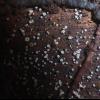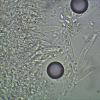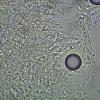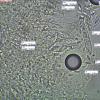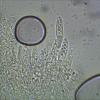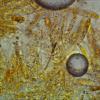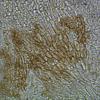
30-12-2025 16:44
Pascal DucosBonjour,Une anamorphe rose stipitée, très nombre

30-12-2025 17:14
 Bernard CLESSE
Bernard CLESSE
Bonjour à toutes et tous,Pourriez-vous aider Albe

29-12-2025 10:15
Hulda Caroline HolteHello, I found and collected this propoloid ascom

30-12-2025 09:04
Hello.A Pyrenomycete sprouting sparsely but very d

29-12-2025 17:44
Isabelle CharissouBonjour,J'aimerais savoir si d'autres personnes au

12-11-2021 00:03
Lepista ZacariasHi everybody,A week ago in my fiels trip I noticed

29-12-2025 17:12
 Bernard CLESSE
Bernard CLESSE
Bonjour à toutes et tous,Pourriez-vous m'aider à

.. on a standing, dead log with thousands of fruitbodies, found 11.8. in the Bavarian Forest.
The white, stalked apothecia are downy.
Excipulum prismatica, with end-cells finely rough-warty, partly brown
Asci about 30-35/5-6 µm, IKI+ euamyloid with Calycina-type, often at the base with long-cylindrical refracting content, with croziers
Spores about 4,5-7/1,7-2,5 µm, mostly with two guttules, somewhat fusoid
Paraphyses not very conspicuous - in IKI with brown guttules (also in excipulum cells)
Deep in my mind I had the name Calycina resinae-piceae (I think Zotto once determined a find of mine with this?) and in ascofrance I found this:
http://www.ascofrance.fr/forum/1229/small-asco-on-the-inner-surface-of-pinus-radiata-wood
The spores are almost the same appearance as mine - and I think I am not too far away ...
Can somebody help?
Best regards from Lothar (still working in the Bavarian forest)

this resinae-piceae has actually fusoid spores with a high lipid content (4), while yours are partly clavate and only 2. It reminded me of Psilocistella conincola, but that has hooked hairs. Are you sure that there are no hairs? Perhaps Ciliolarina is also worth a try.
Zotto

Hi Zotto,
yes, there are hairs - i called them excipulum end cells, and they are granulose, sometimes brown. Ciliolarina - yes, surely a good idea. I think I will make another slide later ...
Thank you and best regards from Lothar
P.S. The apothecia were not on resin, but on naked wood.

Hymenoscyphus resinae-piceae is in fact a Ciliolarina too.
this one looks the most like Ciliolarina neglecta, I suppose the paraphyses content was turning violet for a short while and than became brown.
Would you mind drieing a part for DNA extraction for comparisation with neglecta and ligniseda/laetifica.?
Herzlich,
Stip

Dear Stip,
I already dried a specimen and can send you a part of it. But this will - sorry - take some time, because I am very busy and much "on the road" in the next weeks.
Thank you very much for your opinion and interest. Unfortunately, the specimen was three days old before I dried some of it, but I hope it will contain good DNA.
Please attach your post adress in a mail to me: lkrieglsteiner@t-online.de">lkrieglsteiner@t-online.de
Best regards from Lothar

thanks, that would be great! Ciliolarina has my interest for a long time and this neglecta, laetifica, ligniseda group needs more study.
Yes I hope the fruitbodies were dried quick enough but when they were on the edge of full ripeness that will probably no problem.
cheers,
Stip



